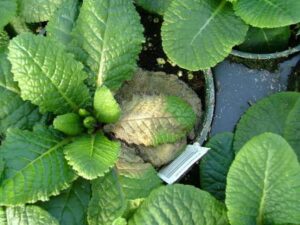Tips on Mitigating Spring Botrytis Concerns
 Many greenhouse growers face Botrytis early in the season as plant materials are densely packed in plug-and-liner trays, shipped, and held in conditions that favor the development of this omnipresent disease. Botrytis is also commonly called gray mold. This fungal pathogen affects virtually all greenhouse and nursery crops with the potential to cause an infection at any point in the season.
Many greenhouse growers face Botrytis early in the season as plant materials are densely packed in plug-and-liner trays, shipped, and held in conditions that favor the development of this omnipresent disease. Botrytis is also commonly called gray mold. This fungal pathogen affects virtually all greenhouse and nursery crops with the potential to cause an infection at any point in the season.
Botrytis can persist in the greenhouse on plant debris under benches as well as actively growing plant tissues, which makes sanitation and scouting key in the management of this disease. Botrytis symptoms can vary in appearance due to several factors including where on the plant it occurs and the current environmental conditions. Symptoms range from leaf spots and stem cankers to petal blight. As the pathogen grows, fuzzy gray spores develop which eventually invade the affected plant area causing decay.
Managing Botrytis needs to be addressed by evaluating the greenhouse environment. Begin by supplying adequate air circulation to reduce the relative humidity in the greenhouse. Allow as much space between plants as is economically possible. Do not be tempted to open vents on rainy days. If it is raining or foggy outside, keep the greenhouse closed and supply some heat. During periods of damp weather, set the thermostats so that the heat runs occasionally throughout the night. Reduced Botrytis pressure can quickly pay back the energy costs.
The timing of irrigation is also important. Growers should limit overhead watering to the morning hours to allow adequate drying time during the day. Horizontal airflow (HAF) fans mix the air effectively, which helps to eliminate pockets of high humidity that develop in the plant canopy and production space, further reducing the potential for condensation. The prompt removal and disposal of infected tissue from the greenhouse also helps to reduce disease pressure.
The ideal environment for Botrytis development is 75°F to 82°F and 80% humidity; however, it will tolerate temperatures down to 32°F. As little as two to three hours of leaf wetness allows the spores to germinate and make penetration into healthy plant tissue. Excess nitrogen can make plant tissue more prone to foliar disease. Current research and grower feedback have shown that foliar sprays of calcium chloride dihydrate help decrease Botrytis outbreaks by increasing tissue and flower calcium concentration. Not only does calcium bind with pectin forming Ca-pectate, which is important for strengthening cell walls, but it also has a direct effect on Botrytis hyphal growth.
Learn more in this post from Griffin.








